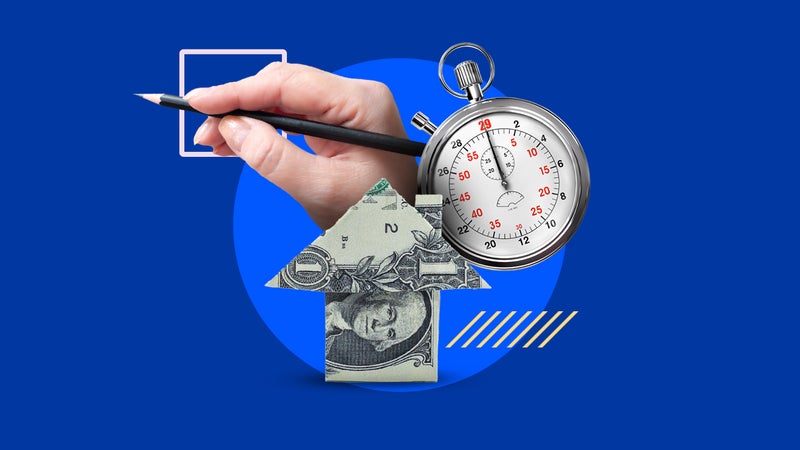Best uses for a home equity line of credit (HELOC)

The Bankrate promise
At Bankrate we strive to help you make smarter financial decisions. While we adhere to strict , this post may contain references to products from our partners. Here's an explanation for .
Key takeaways
- A home equity line of credit (HELOC) is a popular and versatile way for homeowners to access cash by borrowing against the equity in their homes.
- The five best uses for a HELOC are home improvements or repairs, paying for education or emergencies, consolidating high-interest debt, and starting a business.
- Using a HELOC is not recommended for luxury/discretionary purchases, ongoing retirement income, or if your home is your only substantial asset.
One of the most common ways homeowners can tap their residences for cash is through a home equity line of credit (HELOC). It makes available to you, at a variable interest rate, a sum based on the dollar value of your ownership stake.
One of the best parts of a home equity line of credit (HELOC) is its versatility: You can use the funds for almost anything. But, given the nature of the financing, some uses are more suitable than others.
These are the five best uses for a home equity line of credit — and a few that are not so ideal.
Key terms
- Home equity line of credit (HELOC)
- Secured against the value of your home, a HELOC is a revolving line of credit (much like a credit card). You can borrow funds from it as needed for a set multi-year period, repaying in installments. When this period ends, you can no longer draw funds, but must pay off the balance over a new, multi-year period.
5 best uses for a home equity line of credit (HELOC)
HELOCs tend to be taken out for big-ticket expenses: The minimum line of credit you can establish is $10,000, and $30,000 is a common floor for many lenders.
1. Home improvements or repairs
One of the most popular reasons for opening a HELOC relates to home renovations. That’s partly due to the tax advantages: The interest you pay can be deducted on your tax return if the funds are used to substantially improve or repair the home. Also, because a HELOC allows for accessing large amounts of money over time as needed, it can be especially useful for the long-term projects that remodels and renovations so often turn out to be.
Home improvements can increase the overall value of your home, making this specific HELOC use case a wise investment. A garage door replacement recoups over 100 percent of its cost, according to Remodeling’s Cost vs. Value 2023 survey, for example, while a minor kitchen remodeling returns 86 percent.
A HELOC can also be used to make aging-in-place or disability modifications, such as creating a first-floor bathroom or bedroom, widening doorways, or installing a curb-less shower, that make it more accommodating to physical needs. Again, the interest on the borrowed sums could be tax-deductible if you itemize on your tax return.
It’s not unusual for homeowners to access the equity in their homes to buy additional real estate. You could use a HELOC for a down payment on a new primary residence, a strategy known as piggybacking.
2. Paying for education
Homeowners can use HELOCs to pay for the cost of college tuition. This sort of extended expense is ideal for the HELOC structure: You draw funds as you need them — for a semester or a year — owing interest solely on what you actually take out. You (or your child) can also start paying back the debt sooner, instead of being saddled with it all at once after graduation.
Be sure your lender allows HELOCs to be used for this purpose. You’ll also want to investigate all possible student loan options before taking this route, especially federal Direct PLUS Loans (which parents take out). You’d want prevailing HELOC rates to be lower or at least competitive.
3. Using as an emergency fund
It’s always a good idea to have an emergency fund that includes three to six months of living expenses. If you don’t, and the unexpected happens, a HELOC can be used to help cover some of these nasty surprise costs, providing a source for cash fairly quickly (though not as fast as some personal loans).
When using a HELOC for this purpose, however, it’s a good idea to have a repayment plan, so you can aim to start proactively saving. You can’t use a HELOC as an emergency fund forever. The draw period of a HELOC (when you can access funds) lasts about a decade at most. After that, you’ll need another source of ready money.
4. Consolidating and paying off high-interest debt
The credit card bills have piled up on you — either over the years or due to a big expense, like a child’s wedding. Either way, a HELOC can get you out from under, as it generally offers a lower interest rate than unsecured loans, and certainly a lower rate than your credit card’s APR. So it’s a good choice for paying off credit cards or consolidating other types of high-interest debt.
However, be careful. “Using a HELOC to consolidate debt is only a reasonable option if the individual has dealt with their spending issues; otherwise, digging a bigger hole of debt is a likely outcome,” says Steve Sexton, CEO of Sexton Advisory Group, a San Diego, Calif.-based firm of financial advisors.
You can also use a HELOC to pay off student loans, but understand the tradeoffs. Federal student loans, for instance, offer forbearance, deferment and income-driven repayment options should you face unexpected financial troubles. Once you’ve retired your loans, you will no longer have access to these programs — and of course they won’t apply to your HELOC debt.
5. Starting a business
A HELOC can provide seed money to take your side hustle to the next level or provide a stream of cash to fund expenses for an existing business. A HELOC’s interest rates may be lower than those of a comparable business loan. And because a HELOC is a secured loan — meaning your home is used to back it — it may be easier to get approved for one.
Remember, the fact that your home is collateral for a HELOC also has its downsides. If your business fails or you experience unexpected financial challenges that make it difficult to remain current on loan payments, the lender can foreclose on your home.
Is it a good idea to use a HELOC for retirement?
Tapping into your HELOC for retirement can be a convenient and cost-effective way to access large sums of money at potentially lower interest rates. It may be worth it to use home equity for aging-in-place home modifications or sudden repairs, or clearing long-standing debts. Or maybe even to pay off your mortgage, if the HELOC offers a better (i.e., lower) interest rate.
However, using a HELOC to pay ongoing, everyday expenses is not such a great idea: going into debt to make up for budget shortfalls rarely is. Also, if you’re a retiree with limited income, you run the risk of losing your home if you miss monthly payments — and remember, a HELOC’s fluctuating rate can easily cause them to rise unexpectedly. Additionally, taking out a HELOC impacts the value of your home when you die, complicating matters for your survivors and reducing their proceeds if they sell (as it will have to be repaid in full).
When should you not use a home equity line of credit?
Advantageous as it can be, there are quite a few uses for which a HELOC is not suited.
Generally, a HELOC is not recommended if:
- Your home is your only real asset: While this line of credit might offer you a short-term fix, remember it’s backed by your home. That means that if you don’t repay what you borrow, your lender can seize your house. And if debt is already a problem, the open line of credit might tempt you to withdraw more than you really need.
- You can get financing with lower fees and lifetime costs: Few loans come for free. HELOCs, in particular, come with plenty of costs, from upfront expenses like a home appraisal and a title search to ongoing ones like a variable (read: likely rising) interest rate. Make sure you weigh your other financing options, such as a personal loan, so you don’t end up overpaying to borrow what you need.
- You’re only thinking about the draw period: While that draw period phase of the HELOC can seem appealing, giving you access to money as you need (or want) it, all good things come to an end. Don’t forget to consider the repayment phase that follows and the way that will affect your cash flow moving forward. Usually, you’ll be repaying the HELOC for somewhere around 20 years. This is why financial experts generally caution against using HELOCs for purely discretionary expenses, like vacations or weddings, that are joyous but have no investment value.
- Your income fluctuates: In this case, it could be tempting to pull as much as possible from the HELOC, but that could land you in a situation where you struggle to pay back what you’ve borrowed during the repayment period. Remember, monthly repayments can vary due to fluctuating interest rates, creating a strain if your income varies too. In this case, a home equity loan (see below) might be a better option.
- You want to purchase non-essential, big-ticket items: Using a HELOC to buy luxury cars or expensive vacations is risky as it puts your home in danger of foreclosure for discretionary purchases. Additionally, using a HELOC ties you to long-term payments with depreciating assets and reduces your home equity for important needs in the future.
What are the alternatives to a HELOC?
A HELOC is not your only option. If you need access to cash, here are some other alternatives to a home equity line of credit.
- Home equity loan: A home equity loan also uses your home as collateral to secure your debt. It offers a fixed interest rate, so there’s greater predictability when it comes to your payments. On the other hand, you may be stuck with higher interest rates than with a HELOC. And the set sum you borrow may not be enough for your needs.
- Credit card: If you need to pay a short-term expense, try to find the best credit card with a 0% introductory interest rate. This gives you a chance to make your purchases and pay off your credit before interest rates kick in, but you will still need to make timely payments to protect your credit.
- Personal loan: A personal loan is unsecured debt that allows you to borrow funds for any purpose. You do not need any collateral since approval is based on individual factors like your income and credit score. Personal loans typically have shorter terms and carry higher interest rates than a home equity loan, though (but can be cheaper than a credit card).
- Reverse mortgage: A reverse mortgage allows you to access tax-free funds via a line of credit. Your lender makes regular payments to you, similar to how you make mortgage payments to a lender, only in reverse. To be eligible for a reverse mortgage, you must be a homeowner aged 62 or older with equity in your home that you can borrow against. But you must repay the loan immediately if you move or sell the home.
- Cash-out refinance: A cash-out refinance is a new mortgage — one bigger than your original loan, as it includes an extra sum that you receive immediately as ready money. The sum is based on the current amount of equity you have in the home. However, this new mortgage will reset the schedule on your loan, incur new closing costs and could saddle you with a higher interest rate.
- Savings or emergency fund: By dipping into your savings account or your emergency fund, you can preserve the equity in your home and avoid interest payments, an approval process and accumulating debt. However, using any accumulated funds can deplete your cash reserves, leaving you vulnerable for future financial emergencies.
Is a HELOC a good idea in today’s rate environment?
The rising interest rate environment has affected HELOC rates, and — hovering around 9 percent currently — they’re not the bargain they once were, Still, they remain cheaper than other types of debt. Here are some factors to consider when deciding whether a HELOC may be right for you:
- Variable interest rate: Unlike other types of loans that allow you to lock in a specific interest rate, most HELOCs include a variable rate, meaning your monthly repayment amount could rise suddenly and unexpectedly. “Ask yourself whether you feel comfortable having an adjustable rate that can rise if interest rates rise, potentially increasing your monthly payments in the future,” said Matt Hackett, operations manager for mortgage lender Equity Now.
- Funding needs: HELOCs offer the flexibility of borrowing what you need and only when you need it, making them a good choice for those who lack a defined sum or those who require ongoing access to funding.
- Responsible borrowing: Opening a HELOC provides access to a line of credit that you can draw from again and again for as long as 10 to 15 years. Managing this type of fund requires discipline and a plan for repayment, or you can easily get in over your head. “For fiscally responsible people, these can be amazing tools. For folks with less financial discipline or security, they can be devastatingly bad,” says Ryan Cicchelli, founder of Generations Insurance & Financial Services, a Cadillac, Mich.-based financial planning firm.
The bottom line on when to use a HELOC
What is a HELOC used for? Clearly, lots of things. There are many cases in which a HELOC can provide a smart way to leverage the equity in your home to achieve other financial goals or pay for large expenses. Before opening a HELOC, however, it’s always a good idea to shop around and crunch the numbers, ensuring that this line of credit is truly the most cost-effective option. In addition, you should be diligent about responsibly managing the HELOC and develop a clear repayment plan that you can stick to.
Whatever you use the HELOC for, responsible management is the key. “You can do this by only drawing funds that you feel secure in repaying relatively quickly, making timely payments and not digging in too deep,” Cicchelli explains.


